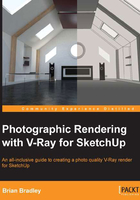
上QQ阅读APP看书,第一时间看更新
What this chapter is all about
Well, after quite a bit of deliberation, much of which was shaped and brought into focus by the hands-on approach to learning that Packt Publishing themselves advocate, I decided to follow the advice of a well-worn axiom: dive right in at the deep end. In other words, develop an introductory exercise chapter that might typically be found at the end of a publication such as this one, often in the form of a "putting it all together" type exercise.
My reasons for opting to take this somewhat turned-around approach were three fold:
- Firstly, as already noted, this approach suits the philosophy promoted by the publishers themselves, which is that learning ought to be as much of a hands-on experience as possible; one that engages and involves the student rather than one that is passive and possibly even tedious.
- Secondly, it gives users, who are brand new to photographic rendering of any kind, the opportunity to see just how easy it can be once they have figured out how to work with the tools of the trade—in this case, SketchUp and V-Ray Version 2.0. My hope is that this chapter can help strip away the mysticism, the trepidation, and maybe even some of the frustration that can result from not understanding how something works.
- And finally, for users who may already be familiar with the general principles of photographic rendering but who are new to V-Ray in SketchUp, this book will give them an opportunity to very quickly get an overview of the process, tools, and options that can be used in a V-Ray-specific pipeline.
So, with the general idea of what this particular chapter is all about made reasonably clear, let's go ahead and dive right in.